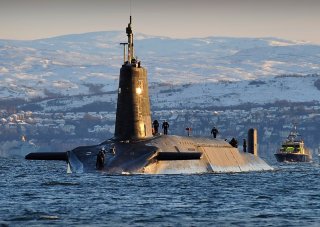No Joke: The Royal Navy’s Dreadnought Submarines Can Kill Anything
The name Dreadnought is steeped in historical significance.
Here's What You Need to Remember: The Dreadnoughts couldn’t come a moment too soon. The first of the new submarines, the HMS Dreadnought, is expected to enter service with the Royal Navy in the early 2030s, keeping the older Vanguard-class operational for “at least 37 years, 13 years longer than the design life.” And once they do—they’ll rule the waves.
The Dreadnought-class of submarines will replace the United Kingdom’s Vanguard-class submarines which currently provide the Royal Navy’s silent underwater nuclear deterrent. Though certainly among the world’s most capable nuclear submarines, the Vanguards have been in service with the Royal Navy since the 1990s, making the oldest of the submarines nearly thirty years old. Former Defense Secretary Michael Fallon stated that the Royal Navy “cannot know what dangers we might face in the 2030s, 2040s and 2050s,” justifying the submarine’s construction.
Construction on the Dreadnought-class is still underway, so many of the class’ final characteristics are not yet known, but BAE Systems, the Dreadnought-class builder, is building a fleet of four total submarines, and claims that the submarines will be the first submarines built with mixed-gender crews.
Composite imagery of the submarines does however show what appears to be a very smooth, streamlined hull with a single, rather large sail near the front third of the vessel. Just rear of the sail, the new submarine is shown with twelve missile compartments, six to a side. The class is expected to be 150 meters long—nearly 500 feet—and displace 17,500 tons, making the Dreadnoughts the largest submarines ever built for the Royal Navy. The submarines will also feature a new lighting system that can simulate night and day, giving underwater mariners a better sense of what time it is, another first for the Royal Navy.
The name Dreadnought is steeped in historical significance. The United Kingdom press release announcing the new submarine’s names stated that, “Dreadnought has extensive historical significance, borne by no fewer than nine Royal Navy ships. A previous Dreadnought sailed with Sir Francis Drake to repel the Spanish Armada; another was present with Nelson at Trafalgar, where her gunnery was acknowledged to be the most devastating of any ship present. But the most famous of all was the ninth Dreadnought—a battleship so advanced that it rendered all others obsolete at a stroke.” The timing of the announcement in 2016 happened to coincide with when “the United States Navy sent four of its own dreadnoughts to join the Royal Navy’s Grand Fleet in Scapa Flow.”
Like the previous Vanguard-class, the Dreadnought-class will be armed with Trident intercontinental ballistic missiles—a ballistic nuclear missile design that is shared with American Ohio-class submarines. You can read more about the Trident in this previous National Interest piece.
The Dreadnoughts couldn’t come a moment too soon. The first of the new submarines, the HMS Dreadnought, is expected to enter service with the Royal Navy in the early 2030s, keeping the older Vanguard-class operational for “at least 37 years, 13 years longer than the design life.” And once they do—they’ll rule the waves.
Caleb Larson is a Defense Writer with The National Interest. He holds a Master of Public Policy and covers U.S. and Russian security, European defense issues, and German politics and culture. This article is being republished due to reader interest.
Image: Wikipedia.

